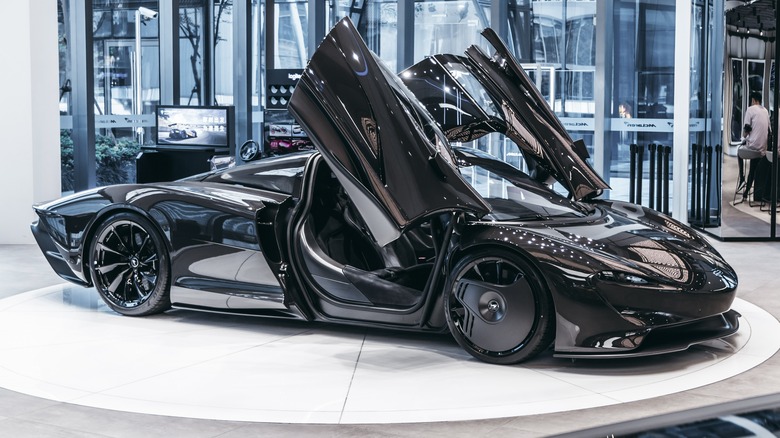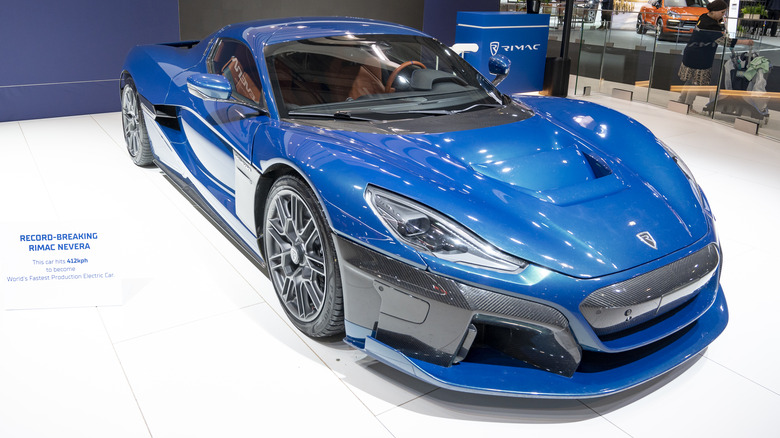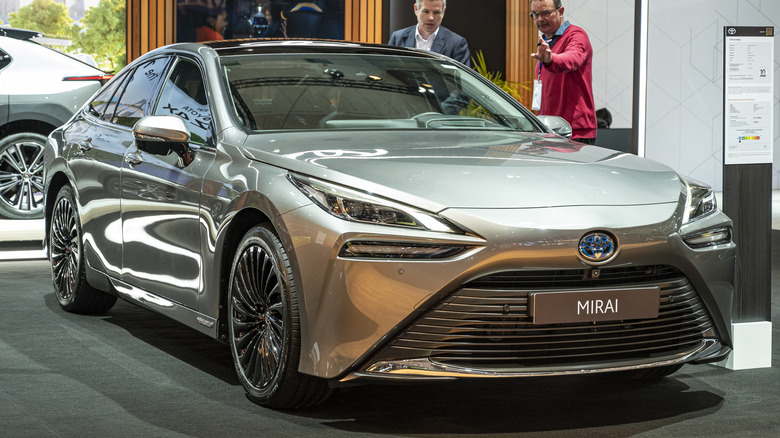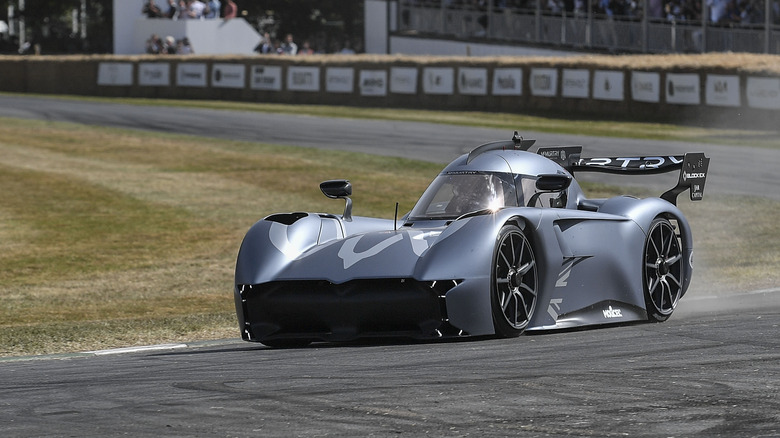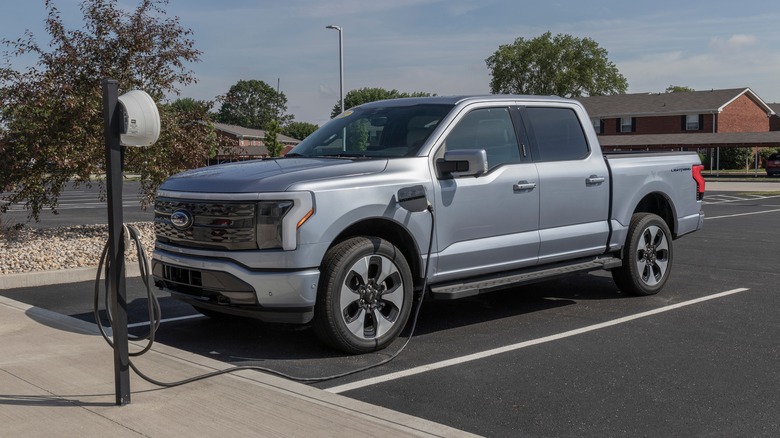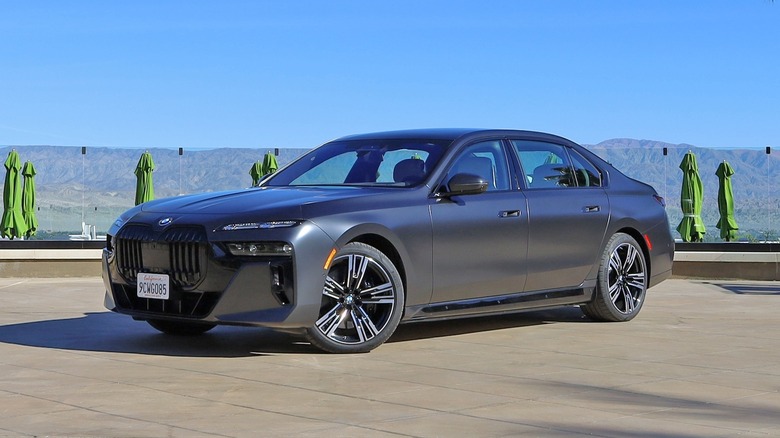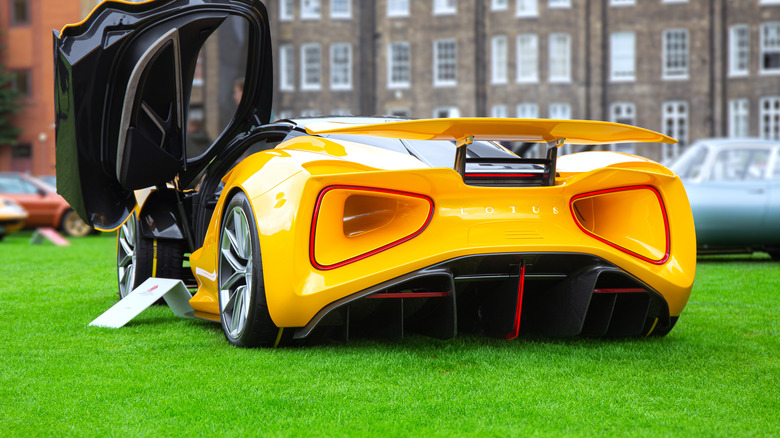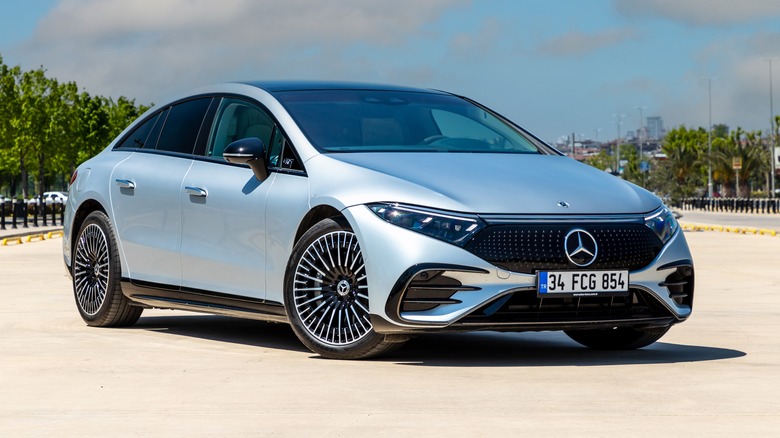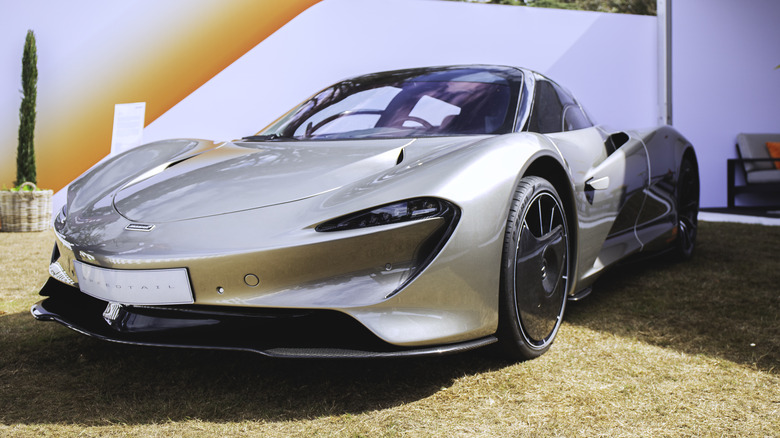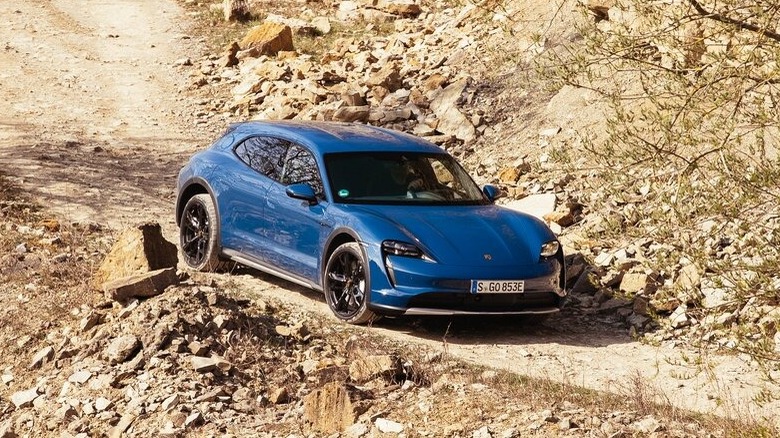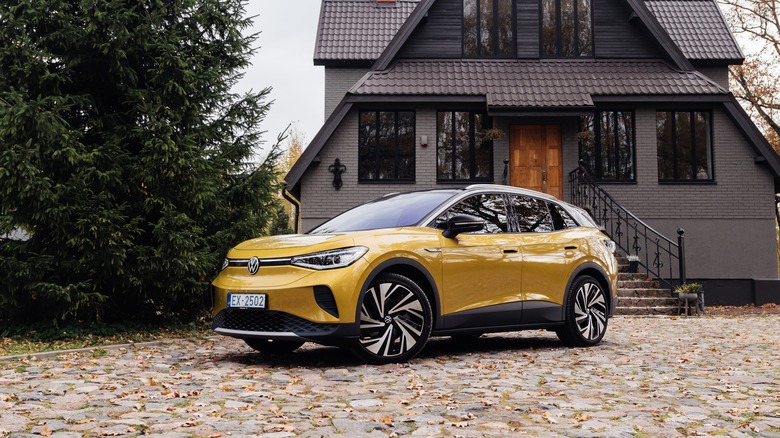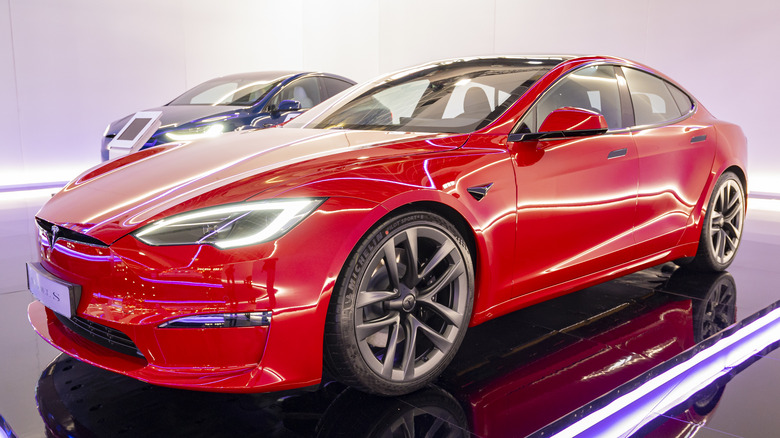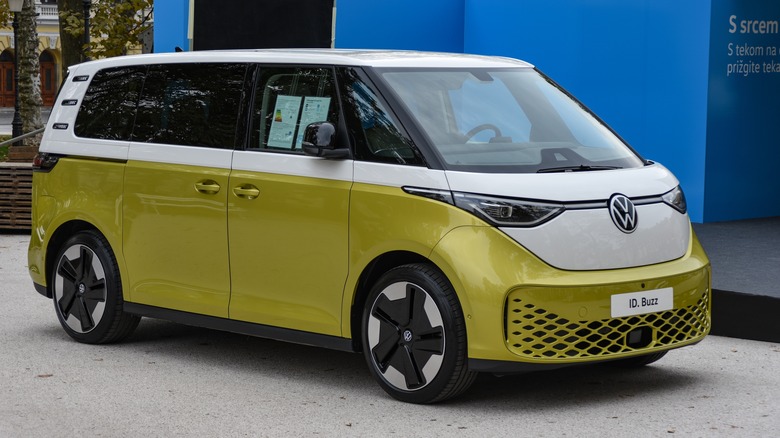The 12 Most Futuristic Cars On The Road Today
Predicting the future is never easy. It wasn't too long ago that car companies were funneling billions of dollars into self-driving car programs, making big promises about full autonomy being just around the corner. While it's true that semi-autonomous cars have made huge progress, they're still far from perfect. Just ask Tesla. Fully-autonomous cars remain a distant prospect, and that's assuming they're accepted by the general public at all. So, if we're not all going to be shuttled around in AI-powered pods by the end of the decade, then what does the future look like for the global auto industry?
You could argue that the best way to answer that question is to take a look at what's on the road right now. There are plenty of cars sporting cutting-edge technology that will likely become tomorrow's normal, not only in the typically progressive segments of the industry including performance and luxury cars but also down to segments like the humble hatchback. The industry's biggest players are just beginning to launch the next generation of cleaner, faster, and more intelligent cars, and there's a handful of disruptive startups that are definitely worth watching out for too. These cars are all among the most futuristic on the road today, in that they represent not only the best of what current manufacturers are capable of but also where the industry might be headed over the coming years.
Rimac Nevera - the hypercar of tomorrow
Alongside its mechanical twin, the Pininfarina Battista, the Rimac Nevera sits in a class of its own as an example of what tomorrow's electric hypercar will look like. In late 2022 it set a world record for the fastest production electric car, reaching 258 mph. That's in addition to the record-breaking 8.582-second quarter-mile run it set in 2021, which ironically, was beaten by 0.03 seconds by the Battista in early 2023. It's common knowledge that EVs can be fast — any Tesla Performance model proves that — but to reach speeds that, just two decades ago, were unheard of even for a gas-powered car is remarkable.
Rimac, unlike the Bugatti Veyron which first crossed the 250 mph production car boundary, did not have the backing of one of the industry's biggest conglomerates, at least not at first. The company was instead set up by Mate Rimac in his garage in Croatia in 2009, growing from a small components manufacturer to eventually merge with Bugatti in late 2021. Today, the company is backed by Porsche under the VW Group umbrella, which all but guarantees that Rimac has the development funds necessary to continue developing groundbreaking EVs. For now, though, it's the Nevera that remains the firm's latest and greatest model, being not only one of the best EVs around right now, but arguably one of the best hypercars, period.
Toyota Mirai - A dark horse
With the race to create sustainably-powered cars now led by battery EVs, hydrogen-powered cars occupy a strange space in the industry. Hydrogen adoption is a bit of a chicken-and-egg scenario: for buyers to make the switch, there needs to be plenty of existing hydrogen infrastructure. But in order for that infrastructure to be built, there needs to be plenty of hydrogen cars on the road to justify building it. The biggest manufacturer to have remained committed to hydrogen since the tech's earliest days is Toyota, which recently launched a second generation of its only hydrogen production car, the Mirai.
At present, it's limited to places where hydrogen filling stations are accessible, which is almost exclusively California. Of course, it's possible that hydrogen cars will never gain mainstream adoption, but there is evidence to suggest they might still become popular eventually. Years after it abandoned its initial hydrogen efforts, BMW recently announced it was launching a pilot fleet of iX5 cars in Europe, with the idea of "paving the way for potential series production." Hyundai also currently sells its hydrogen-powered NEXO in California, albeit in small numbers. Hydrogen cars solve two of the biggest problems with BEVs: they can be refilled in a few minutes, and their range is similar to that of a gas-powered car. If hydrogen infrastructure can be upgraded, it's still possible the tech could properly take off. In that sense, the Mirai might be just ahead of its time.
McMurtry Spéirling - Motorsport's next step
The electric McMurtry Spéirling might just be one of the most unique-looking cars of recent years. First things first — it's absolutely tiny, with barely room for one seat. It looks like someone built a full-size race car and then shrunk it in the wash. Second, its unique proportions were designed specifically to reduce drag as much as possible, with minimal reliance on the usual downforce-generating aero bits. Thirdly, it's absurdly quick — a fact it proved in 2022 by shattering the all-time Goodwood hill climb record, clocking just 39.08 seconds.
This unbelievable speed is made possible by its diminutive weight, high power output, and dual fans that draw air from under the chassis and blast it out the rear of the car. This essentially produces downforce on demand, even when the car is at a standstill, allowing it to transfer all of its power to the asphalt even at low speeds. The Spéirling is primarily designed as a track day toy, but a road-legal version is also available. It starts at £820,000 (roughly $1 million) plus taxes, but for that, you'll get a car that's faster than pretty much anything else on the road, including hypercars that cost several times as much. This fan-assisted EV may very well represent both the future of motorsport and the future of high-end road cars, so expect to see a lot more of the McMurtry name over the coming years.
Ford F-150 Lightning - The pickup of the future
Despite losing ground to SUVs over the past couple of years, pickups remain one of the most important segments of the American auto industry. Like every other segment, manufacturers are increasingly looking to electric powertrains for the next generation of pickups, with Ford launching the "Lightning" EV version of its best-selling F-150 in 2022. High demand and a temporary production stoppage have meant that waiting lists for the F-150 Lightning have been growing, with over 200,000 reservations made before the truck even hit production.
Reception to the F-150 Lightning has been largely positive, although a highly-publicized video from YouTube channel "Hoovie's Garage" cast doubt on the truck's towing capacity claims. This is an issue that Ford will likely fix over time, and eventually, it's not hard to see the gas-powered F-150 phased out altogether, especially if America ends up adopting legislation that bans internal combustion, as Europe and parts of China are already set to. Rivals like the Rivian R1T also deserve a mention as potentially being the pickups of the future, but Rivian's struggles with supply chain and scaling issues show it's a long way off from being able to compete with the Big Three automakers.
BMW i7 - Next-gen entertainment
While the switch to electric powertrains has drawn the most headlines in recent times, big technological leaps have also been made in other areas of the auto industry. One of the biggest has been the transformation of in-car entertainment. It wasn't too long ago that the best entertainment most rear-seat passengers could hope for was listening to the radio or their favorite CD, but with the latest generation BMW i7, they now get access to a 31-inch "Theater Screen" that transforms the back of the car into a mobile cinema.
The screen is an optional extra and one of many new features that debuted for the 2023 model year, but it's well worth the added cost. It displays content in up to 8K resolution and supports ultra-widescreen formats, so passengers can enjoy movies without annoying black bars. The screen is controlled through touch panels on the rear doors and features various integrated streaming apps like Amazon Fire TV and Twitch for optimal variety. Of course, this screen is a redundant feature if you're the kind of person who actually wants to drive their own car. But, if you've got a handy chauffeur (or you have kids and therefore you are the chauffeur), the BMW's Theater Screen represents cutting-edge in-car entertainment.
Lotus Evija - Ultimate power, unique design
Any carmaker can design a far-out concept car, show it off at a few auto shows, then park it in the back of a storage facility to be forgotten about. However, very few can design a car that looks incredibly futuristic, then actually see it through to production. Especially if said car also happens to be the world's most powerful production car. However, that's exactly what Lotus managed to do with its Evija hypercar when it entered production in late 2022.
Originally unveiled in 2019, the Evija promised 2,000 PS (around 1,973 horsepower), but then a rival, the Aspark Owl, came along with 1,984 horsepower. So, Lotus decided to create a special "Emerson Fittipaldi" edition of the Evija with 2,011 horsepower, just to make sure it could claim the "most powerful car" crown. Another impressive thing about the Evija is its design. From the front, it looks somewhat similar to other hypercars of its type, but from the rear, it looks nothing like anything else on the road. The car's tail lights wrap around prominent airflow channels, while the sculpted wheel arches round out its flowing frame. After years of relying on old designs in the form of the Elise/Exige and Evora, it's good to see Lotus back at the cutting edge of performance car design. It's even better than some of the design language from the stunning Evija has trickled down into the Emira, the brand's last gas-powered car.
Mercedes-Benz EQS - A tech-heavy luxury S-Class
Despite many challengers over the decades, the Mercedes-Benz S-Class remains the benchmark in its segment. It's the executive sedan that all others want to be, including, oddly enough, the German brand's in-house rival, the EQS. While the EQS has been widely labeled as the "electric S-Class," Mercedes-Benz stopped short of giving it the full S-Class name. There's a good reason for that: the EQS takes a slightly different approach than simply being a regular S-Class with an electric motor, which is evident from both inside and outside the car. With its smooth, flowing lines and sharply-tapered lights, the EQS has all the exterior design hallmarks of a typical performance EV.
Stepping inside is where things get really futuristic: SlashGear's Chris Davies noted the cabin is like a "space-age lounge," particularly with the optional Hyperscreen fitted, which combines the dash and center console into one giant touchscreen. It displays an almost overwhelming array of widgets and controls, but voice control is also on hand if you can't find the function you need at a glance. Punch the accelerator and the car pushes forward, feeling eerily similar to a gas-powered S-Class in its lower-powered configurations. Eventually, the EQS line might integrate back into the S-Class lineup, as electricity becomes the default means of propulsion. For now, though, the EQS remains a fascinating offshoot of a luxury favorite, with more cutting-edge tech than anyone could really ever need.
McLaren Speedtail - Pioneering construction
As McLaren's first 250 mph car, it's little surprise to find out that the Speedtail took some clever engineering to make it a reality. Getting a car to this speed requires both plenty of power and minimal drag, and McLaren dealt with the former by installing a 1,055 horsepower hybrid gas-electric powertrain. To achieve the latter, the car's body shell was stretched to over 17 feet long, and even the mirrors were removed and replaced with side-mounted cameras.
Perhaps the Speedtail's most striking innovation, however, is one that's nearly invisible. The carbon fiber bodywork at the rear of the car is built to be flexible, creating "active rear ailerons" that can be hydraulically adjusted to change the car's shape. This allows for optimal airflow at top speed, without the need for a large rear wing or any of the usual downforce-inducing aero bits. With a price tag of around $2.3 million and a limited production run of 106 units, this innovative flexible bodywork can only be admired by the Speedtail's billionaire collectors. However, as major automakers look for ways to reduce drag and optimize airflow to squeeze every last mile of range out of their EVs, there's a chance that flexible bodywork might yet feature on more affordable cars in the future.
Porsche Taycan CrossTurismo - The complete package
Since the Taycan first launched in 2020, it's proven itself to not only live up to Porsche's legendary driving experience but also remain a commercial success. It first overtook the 911 in global sales numbers in 2021, and with the launch of the CrossTurismo, now comes in both sedan and wagon flavors. Out of the two variants, it's the CrossTurismo that stands out as the most futuristic, because it represents almost the complete package for Porsche enthusiasts.
The brand's sports car range still leads the way in terms of pure driver enjoyment, but a 911 or 718 is never going to be that practical as a daily driver. The Cayenne and Macan SUVs are much more practical, if not quite as fun to drive, and most variants are still a long way from being eco-friendly. The Taycan CrossTurismo is arguably the best compromise of all, as it's fast, more fun to drive than an SUV, and still surprisingly practical. Plus, its electric powertrain means it's greener than a Panamera, which is the closest Porsche gets to a gas-powered equivalent of the Taycan. With its higher ride height, spacious trunk, and some gravel and mud capabilities, the Taycan CrossTurismo incorporates enough elements of what most SUV buyers want, without sacrificing the slippery dynamics of a sporty EV. Expect to see more halfway-house EVs of this type as electric performance cars slowly become more commonplace in the future.
VW ID.4 - Tomorrow's everyday
Toyota might still be the world's largest carmaker but it's been woefully trailing behind on battery EVs — while other manufacturers are launching entire EV lineups, Toyota has only just launched its first BEV, the weirdly-named bZ4X. The world's second-biggest automaker by volume, VW, has been much more proactive on this front, and as a result, is poised for significant growth as buyers make the switch to electric. Sales of its EV line grew by around 24% in 2022, with the ID.4 being the group's top performer with 170,000 units delivered. That's not close to the sales figures of market leader Tesla yet, but it's worth noting that VW has a notable long-term advantage over Tesla.
For starters, VW has a vastly larger global dealership network and doesn't have to deal with the costs associated with expanding into new markets. It also has a much bigger existing customer base, the majority of whom might own gas-powered cars at the moment, but are likely to switch to EVs in the future as they become the default option in dealerships. It also has near-unlimited development funds and can share costs among subsidiaries like Audi and Porsche. All that makes it seem very likely that VW will eventually overtake Tesla to become the biggest player in the EV space. As today's best-selling VW EV, expect the ID.4 to play a big part in shaping what the future's everyday traffic will look like.
Tesla Model S - The car that made Musk
Since they've now become best-sellers, it's easy to overlook just how futuristic Tesla's current crop of cars actually are. For better or for worse, Elon Musk has remained keen to deploy the latest innovations in self-driving and convenience tech to Tesla owners as soon as possible, with scores of innovative features that aren't available from any other manufacturer. This hasn't always gone well — the recent Full Self-Driving recall came at a pretty bad time for the company, with Tesla stock taking a nosedive and investors worried by Musk's recent obsession with his new toy, Twitter.
None of that takes away from the fact that cars like the Model S are still some of the most technologically advanced EVs out there, with class-leading ranges, self-driving abilities, and frequent over-the-air software updates. Musk has largely delivered on his mission to make world-beating EVs, even if the company has lost its way a little in recent months. Now all he's got to do is ensure that the Cybertruck actually reaches production.
VW ID.Buzz - The new nostalgia
One of the key disadvantages that startups like Tesla and Lucid Motors have is that they're not able to boost their sales by drawing on nostalgia. It's a highly effective tactic for more established automakers — take a look at the success of the relaunched Ford Bronco for a recent example. VW is also planning to bring back the Scout as an American-made electric SUV, but it's not the first time that the German brand has used references from the past to boost the image of its EVs.
Despite its clunky name, the ID.Buzz takes clear inspiration from the classic VW Bus, with retro-inspired styling that aims to evoke the surf-chic classics of the '60s. It's proved to be a hit, with waiting lists currently sitting at up to 18 months long in some markets, proving yet again that there's always room in the industry for a healthy dose of nostalgia. Plenty of EV makers have so far focused on making their vehicles simply feel as cutting-edge as possible, but expect to see more manufacturers hop on the retro-modern trend in the future after seeing the success of the trailblazing ID.Buzz.
